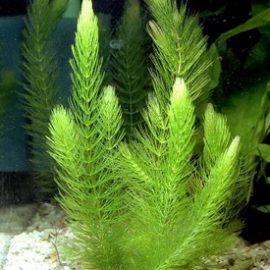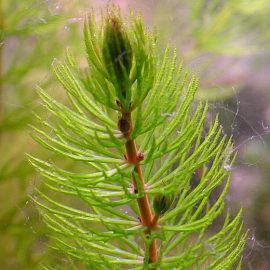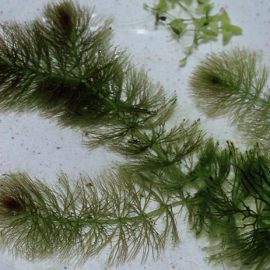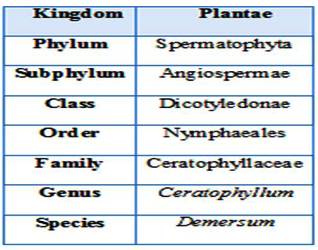Suhas S. Awati1,2*, Ritu M. Gilhotra1, Santosh K. Singh1, Vinit Raj1, Kiran A. Wadkar3
- School of Pharmacy, Suresh Gyanvihar University, Jaipur, Rajasthan, India 302025.
- Dr. Shivajirao Kadam College of Pharmacy, Kasabe Digraj, Dist. Sangli, Maharashtra, India 416305.
- Appasaheb Birnale College of Pharmacy, Sangli, Maharashtra, India 416416.
ABSTRACT:
Ceratophyllum demersum Linn.(CD) from the family Ceratophyllaceae is the significant & appealing marine macrophyte that has a slight affirmation in customary arrangement of medication as an pain relieving, antipyretics, anti-inflammatory, astringent, antiulcer, antidiabetic, anticancer and so forth. There isn’t as quite a bit of data existing about phytoconstituents & therapeutic possessions of plant. Till date aggregated evidences about its therapeutic properties, phytoconstituents & further associated data are missing. In this review, we found that the plant CD. contains distinctive phytoconstituents like flavonoids and glycosides, sterols, terpenoids, sugars, tannins, proteins, volatile oil, alkaloids. Medicinal and other related data of CD. and fill the information hole in this specific field & supports further assessment on the plant & other oceanic macrophytes by way of these totally will benefit in making potential biopharmaceutical thing.
Keywords: Ceratophyllaceae, Hornwort, Ceratophyllum demersumL., marine macrophyte,
INTRODUCTION



Figure: 1. Ceratophyllum demersum plant
Family- Ceratophyllaceae
Distribution: Plant occurs all through world in aquatic circumstance e.g. tanks, Ponds, riverbeds, seacoasts.
Table 1: Alternative names of Ceratophyllum demersum Linn.
| Region | Alternative name |
| Hindi | Sivar, Kai |
| English | Coontail, Hornwort |
| Sanskrit | Jaiaja |
| Kannada | Cande |
| Malayalam | Karimpayal |
| Telugu | Nasu |
| Marathi | Saival |
| Japan | Marsumo |
| Taiwan | Hornweed |
| United Kingdom | Rigid Hornwort |
Propogation: Seeds, plant sections.
Habitat: Inland and beach front lakes, lakes and moderate moving streams and rivers. Tolerant of hard water (high calcium content) and low light levels.(1,2)
Table 2: Scientific ClassificationofCeratophyllum demersum Linn.

Description:
Ceratophyllum demersumL. (CD)is an aquatic herb, around eight inches to three feet in length, thickly leaved, green in shading. Leaves close around one inch long which are spread in water &shaping net-like, between together, over the water surface, step by step a thick inclusion on the water surface. It is comprehensively obtained in the lower side of lakes.(3)
CD is a submerged trustworthy macrophyte that will as a rule conveyed with the establishment of its stem covered up in grimy or silty substrates. It doesn’t generate roots.
Nomenclature:
Leaf: The 1.6- 4 cm long leaves are branched into 2 (sometimes 4) straightened or linear segments with minor teeth along one edge. The leaves are regularly fairly hardened or crunchy. They are arranged in whorls of 5 to 13 leaves with the whorls getting thick towards the stem tip.
Stem: Prolong, 30cm- 60 cm long, unreservedly fanning and either delicate solidly extended or string like and versatile; hubs 1cm- 3 cm separated however becoming crowded near the tips.
Root: Roots are missing, replaced by finely isolated basal stem branches named ‘rhizoid shoots’ Floats openly underneath the surface, or is in some cases anchored to the base by altered leaves, particularly in streaming water.
Flower: Greenish, Tiny, little to one mm long, unisexual, separated& sessile in leaf bases, every subtended in 9- 12 calyx-like bracts, male & female blossom byoccur independently on the similar plant.; female blossom brief ovary surmounted by a solitary straightforward style and single; The male blossoms happen two by two on inverse sides of the stem, with 12 to 15 sessile elongated anthers each ending in 2 sharp focuses. Blooming happens from June to September.
Fruit: The little (4-7mm), Black ellipsoid achenes, hard, one-seeded, egg shaped fruit has 3 long spines, one spine at the fruit tip and 2 at the base.
Seed-The fruit goes about as seed.(5)
Chemical Constituents:
The plant CD extracts comprise of various types of phytomolecules for example, flavonoids, alkaloids, glycosides, tannins & cardiac glycoside.(6,7) CD incorporates magnesium, calcium dry matter, nitrogen free extract, crude protein, crude fibre, crude Fat & ash.(8, 9, 10) The essential oil obtained from the CD was isolated by the steam distillation method & the structure of isolates identified by GC- MS.
Table 3: The chief constituents identified from essential oil of the plant CD include:(11,12)

Apigenin-7-O-glucoside isolated and identified as a flavonoid glycoside & sitosterol in another investigation. Volatile composites were isolated and identified mainly as sesquiterpene, n-paraffins, benzyl acetate.(13) In another investigation of the extract of CD reported β –carotene, Gentisic acid, ferulic acid,vitamin C and Coumaric acid.(14)
Table4: Important Chemical Constituents of Ceratophyllum demersum Linn.


Traditional Uses:
The ethnomedicinal usages of the plant CD recommended in the treatment of different maladies. The juice of CD with sesame oil is recommended for the treatment of discoloured skin.10 to15ml of aqueous extract of plant given two times in a day for 7 to 10 days for the treatment of biliousness and ulceration.(15,16)
Leaf is utilized as antipyretic, to control bile release& cardio tonic. Pest of leaves is smeared on the superficial level in occurrence of scorpion nibble.(17, 18, 19) It is utilized as antipyretic, healing agent, antitoxic, astringent, pain-relieving, anti-inflammatory, hepatoprotective, anti-diarrheal& in the respiratory infections.(20)
The plant is bitter, oleaginous, refrigerant, fragrant, constipating &is helpful in circumstances of pitta, burning sensation, hematemesis, dysentery, epistaxis, diarrhoea, haemorrhoids or piles, ulcers, hyperdipsia, haemoptysis, & intermittent fevers.(21,22,23) In Indian medication, the plant CD is utilized in jaundice, in the treatment of malaria and for scorpion bites(24); in China its ancient with haemoptysis, watery dig up of the established in contradiction of diarrhoea & wound restoring impact.(25)It is endorsed for CVS infections, rheumatism, giddiness, morbid thirst, haemothermia, leucorrhoea, spermaturia, venereal diseases.(23, 26)
In Sushruta The whole plant CD is utilized traditionally as antidiabetic.(27)
In Ayurveda; Charaka used the whole plant, in prescriptions, for hypothermia, dizziness, morbid thirst; externally in rheumatism, erysipelas.
Shaivala, in Ayurvedic writings, has a place with Bhadrashriyaadi Group, which is recommended in natural haemorrhages. Sushruta utilized in the treatment of spermaturia.
In conventional medication, it is utilized to stop the bleeding when it is applied to a wound; additionally recommended in leucorrhoeato stop thick, whitish vaginal release & sexually transmitted aliments. Its ash is applied superficially on discoloured skin with sesame oil. The paste is utilized externally in inflammations.(28)
Charaka recommended the seeds of CD taken with Ushira: Vetiveria zizaanioides & Dhaanyaka: Coriandrum sativum in vomiting and digestion problems. On account of unnecessary consuming sensation and in fever, the soup of seeds of CD was recommended (Bhaavaprakaasha). Maadhava Dravyaguna recognised antibilious, blood-purifying potential to seed of CD yet furthermore considered it punsatvaghna for example it is responsible for impotency. (28)
Pharmacological review of plant Ceratophyllum demersum Linn.
Thomas Abu 2017 and Ibrahim Syed, et. al., 2018 revealed as a pharmacological survey of the medicinally significant plant CD that has been depicted by numerous authors, I have outlined major pharmacological exercises that have been reported. (24, 29)
- Antidiarrhoeal & wound curative activity:
The methanol & aq. extracts of whole plant CD were assessed for in contradiction of diarrhoea & wound restoring possibilities utilizing different test models. The 250 mg/kg & 500 mg/kg dose is utilized for assessment of antidiarrhoeal potency. Both extracts shown significant antidiarrhoeal &major wound curative activities. It might be contemplated that; methanol and aq. extracts has hostile to diarrhoea and wound restoring exercises, which support the utilization of the total plant in constant medicine deal with the free guts and wound.(30-33)
- Antioxidant & anti-acetyl cholinesterase potential:
DPPH radical scavenging & ferric reducing antioxidant power assay method was utilized for screening of antioxidant potentialat different concentrations. Folin-Ciocalteau’s reagent method is used for determination of total phenol contents present in the extracts.528.29±4.07 of total phenol content found in extract of CD & percentage of DPPH radical scavenging activity was found to be 39.3±1.11; 22.6±0.62 & 12.2±1.06 at2.0; 1.0&0.5mg/ml conc. Respectively and as a Standard Gallic acid shown percentage of inhibition at the same conc. i.e. 93.2±00, 92.6±0.10 and 91.6±0.06.
In FRAP, the absorbance were obtained 0.329±0.02 & 0.609±0.02 at conc. 0.5 & 1.0 mg/ml; Standard Gallic acid: 3.569±0.02 & 3.677±0.02at same conc. (34)
In vitro free radical scavenging potential of aqueous & methanol extracts from in vitro proliferated CD utilizing DPPH were researched. DPPH scavenging potential water & methanol extracts was found to be 68.91% & 51.22% at conc. 10mg/ml and IC50 values 3.689 mg/ml & 10.301 mg/kg respectively. Standard Gallic acid was showed 0.029 mg/ml with statistically significant (p<0.05).(35)
Another investigation showed that the inclusion of the aquatic macrophyte CD to dichlorobenzene (DCB) method had the option to cause an enactment of the antioxidant framework, showing an isomer unequivocal model, which suggests that the protection arrangement of the plant is expecting a huge activity in scavenging ROS, assisting with guaranteeing the organism against horrible oxidative effects delivered by the prooxidant movement of the attempted xenobiotics.(36)
Antimicrobial Potential:
The antimicrobial capability of CD with other macrophyte were extracted with solvents; acetone, butanol & methanol and decided the potency against pathogenic organisms like Gm+ve, Gm-ve bacteria & fungi through agar well dissemination method.
The 50% acetone extract of CD triggering 18mm zone of inhibition against fungi indicates that antifungal potency. The plant extract did not shown any action against Gm+ve, Gm-ve bacteria.(37)
In another examination, extracts of CD with other plants attempted for in vitro antimicrobial action against 17 different microorganisms(MO) including Gm+ve, Gm-ve bacteria.& fungi; 09 of these recognized organisms were gained from various sources. The other 08 organisms were quarantined from alternative source &perceived by utilizing API 20E strip framework. Hundred pathogenic bacteria separates signifying 08 genera were perceived to species level. The extract displayed antimicrobial activity in logical inconsistency of the entirelytried organisms.(38)
- Antiinflammatory & Antineoplastic potential:
Along with other plant extract; hexane extracted essential oil components of CD assessed for the antineoplastic &activity against inflammation through prediction activity spectra for substances (PASS). The foreseen estimation of antineoplastic & activity against inflammation showed twelve composites with above0.8 probability value & distinguished as; 2,6-Dimethylcyclohexan-1-ol, beta-ionone, biformen, 2-Phenylacetaldehyde, alpha-murolene , kaurene, Octa-3,5-dien-2-one; alpha- eudesmol, Hepta-2,4-dienal,geranylacetone, manol and beta-eudesmol.(39)
By utilizing the Carrageenan persuaded rat paw edema model; the anti-inflammatory action at dose250mg/kg & 500 mg/kg body weight of methanolic concentrate of CD was tried with control 1% CMC at dose 10 mg/kg & Nimesulide at dose 50 mg/kg. The methanolic concentrate of CD at the same dose showed paw volume reduced significantly (p < 0.01). (39)
- Analgesic Action:
By utilizing acetic acid persuaded writhing model in albino mice; methanolicextract of CD (250mg/kg& 500 mg/kg of body wt.) were affirm the analgesic potential. The extract demonstrated critical fall in quantity of writhes therefore showing its pain relieving movement dependent on dose.(40)
- Antipyretic Action:
For assessing antipyretic action of CDin rats; Brewer’s yeast persuaded pyrexia technique utilized. The dose of 250 mg/kg body wt. of methanolic extract demonstrated huge diminished pyrexia & the number of writhes and paw volume decreased at the conc.500 mg/kg body wt. indicated reduction in pyrexia essentially, hence displaying its antipyretic movement.(39,40)
- Antiulcer Action
Methanol & aq. Concentrate of CD was assessed for antiulcer action at a conc. of 250 & 500 mg/kg body wt. It demonstrates that, both the concentrates at 500 mg/kg indicated noteworthy rise in pH, reduction in gastric acid volume& total acidity. In this manner, C. demersum shows antiulcer potential, hence whole plant utilized to treat ulcer condition.(41,42)
- Genotoxic & Allelopathic capacity:
By using ‘Mussel micronucleus test’ the genotoxic capacity of aq. concentrate of CD was assessed together with other marine herbs to discover conceivable association with the complete tannin and polyphenol content. From the haemolymph of painter’s mussel (Uniopictorum L.); micronucleus frequency was determined
In similar, total tannin and hydrolysable tannin matters were assessed. Remarkable mutagenic impact shown by the plant extracts. Noteworthy connection was resolved between mutagenic limit & tannin content. It showed that tannin is responsible for genotoxicity limit which may recommend this plant to clarify a genuine environmental impact in the ecosystem. (43)
The Allelopathic action of CD was additionally assessed and a bioassay-coordinated technique advancement uncovered ideal extraction solvents for allele chemicals from the plant. Additional fractionation through liq.–liq. extraction& solid phase extraction methodology demonstrated that the marine macrophyte seem to have hydrophilic & moderately lipophilic active fraction. The macrophyte furthermore displayedactive composites allele pathically into the surrounding medium as seemed by SPE of their incubation H2O. (44)
In another examination, the prospective associations amid the phytochemical composites i.e. alcohol, hydrocarbons, phenols, heterocycles, acidsrecognized within the plant extract & along these lines the allelopathic possessions against Gm+ve and Gm-vebacteria & microalgal cultures were researched.
The Dried plants incubated for twenty five minutes at 50°C undergoes untargeted solid phase micro extraction (SPME) GC-MS investigation revealed that phenols are the significant constituents of the volatile finger impression with a relative pinnacle area above 13%, in particular: 3,5-bis (1,1-dimethylethyl); 2,6 bis(1,1-dimethylethyl)-4(1-oxopropyl) phenol.(45)
CONCLUSION:
Natural things have been a basic resource for the affirmation of life and are getting rising hugeness as different prescriptions. CD had a wide history of ordinary uses for wide extent of illnesses. Experimentally proved biological activities of this plant are used in battling the different maladies. Be that as it may, explicit affirmation of the set as a common medication is deficient. It has been deductively demonstrated that this plant have various biological activities. Regardless, the preeminent difficulties in the propelled day treatment are the undesirable possibilities and the productivity in management of disease. A further examination requires utilizing the isolated composites from other marine macrophytes to explore its potency against the treatment of various maladies with the negligible/ not at all side effects. All the more in this way, guaranteeing the safe use of these plants ought to be strived more. This deposit is used in sort out to variety a trademark through a lot of diseases lighten and economical regimen to be had for poor people in emerging possible biopharmaceutical product.
REFERENCES
- Vaidyaratnam PS,Varier’sAryavaidyasalakottakal. Indian Medicinal Plants. Vol. II. Madras: Orient Longman Ltd. 1997.
- Gyanendra Pandey. Dravyaguna Vijnana. Oriental Publisher and Distributors. III: 287-288.
- Umberto Quattrocchi, F.L.S. CRC, World Dictionary of Medicinal and Poisonous Plants : Common Names, Scientific Names, Eponyms, Synonyms and CRC Press, Taylor & Francis Group, Florida, United States, 2012: 892.
- Keskinkan, M.Z.L. Goksu, M. Basibuyuka, C.F. Forster: Heavy Metal Adsorption Properties of a Submerged Aquatic Plant (Ceratophyllum demersum),Bioresource Technology, Elsevier Ltd. 2004; 92: 197-200.
- T. William Thomas Parsons, E.G. Cuthbertson: Noxious Weeds of Australia. CSIRO PUBLISHING, Australia, Edition2, 2004: 376-377.
- Ashok DT, Atul MK, Karale S, Yashodhan BW. Evaluation of Antidiarrhoeal and Wound Healing Potentials of Ceratophyllum demersum Whole Plant in Rats. Lat. Am. J. Pharm. 2011; 30 (2): 297- 303.
- Malathy R, Shaleesha AS. Studies on the potential therapeutic effects on the aquatic macrophytes namely Cabombaaquatica, Ceratophyllum demersum and Journal of Chemical and Pharmaceutical Research.2015; 7(4):479-483.
- Anjana B, Matai S. Composition of Indian Aquatic Plants in relation to utilization as Animal forage. Aquat. Plant Manage.1990; 28: 69-73.
- Linn J, StabaEJ, Goodrich RD, Meiske JC. Otter by DE. Nutritive value of dried or ensiled aquatic plants I. Chemical composition. Journal of Animal science. 1975; 41:601-609.
- Fareed MF, Haroon AM, Rabeh SA. Antimicrobial Activity of some Macrophytes from Lake Manzalah (Egypt).Pakistan Journal of Biological Sciences.2008; 11 (21): 2454-2463.
- Xian Q, Chen H, Zou H, Yin D. Chemical composition of essential oils of two submerged macrophytes, Ceratophyllum demersum and VallisneriaspiralisL. Flavour Fragr. J.2006; 21: 524– 526
- Xiao-Li L, Ying Q,Xian-Min Z, Bo-Lin M, Ming-Hua Q. Chemical constituents from Ceratophyllum demersum (Ceratophyllaceae). Acta Bot. Yunnanica. 2003; 29: 263-264.
- Bankova V, Ivanova P,Christov R, Popov S, Dimitrova-Konaklieva St. Secondary metabolites of Ceratophyllum demersum. Hydrobiologia. 1995; 316(1): 59-61.
- Kartal M, Orhan I, Abu-Asaker M, ŞenolFS, Atici T, Şener B. Antioxidant and Anticholinesterase Assets and Liquid Chromatography-Mass Spectrometry Preface of Various Fresh-Water and Marine Macroalgae. Pharmacognosy Magazine [Phcog Mag].2209; 5(20): 291-297.
- Pullaiah T. Encyclopaedia of World Medicinal Plants (Vol. 1). New Delhi: Dayabooks; 2006: 513-514.
- Vaidyaratnam PS. Indian medicinal plants: Ceratophyllum demersum Linn, Orient Longman Ltd., Madras. 1997; 2: 56.
- Arvind S, Manavendra KS, Dharmendra KS, Ritesh S. Ethnomedicinal studies on wetland plant diversity of district Buxar (Bihar, India). Unique Journal of Pharmacy and Biological science. 2013; 01(02):18-20.
- Sing OR, Das B, Padhi MM, Tewari NS. Common herbs used in different skin disorders as described in ayurvedic classics. Ancient science of life. 2003; 22(3): 88-94.
- Subramanyam K. Aquatic Angiosperms: A systematic account of common Indian Aquatic angiosperms. Botanical Monograph 3:I-VI. New Delhi, CSIR, 1962: 1-190.
- Indian Herbal Remedies: Rational Western Therapy, Ayurvedic and Other Traditional Usage, Botany. Springer-Verlag Berlin Heidelberg, New York. 2004: 140-141.
- Ya V B, Aquatic plants of the Far East of Russia: A review on their use in medicine, pharmacological activity, Bangladesh Journal of Medical Science. 2015s; 14:9-15.
- Vasudevan Nair. Indian medicinal plants: A compendium of 500 species. Orient Blackswan. 1997.
- Yuan Z,Xie Y. Illustrated Encyclopedia of Chinese herbal medicine. Peking: Zhongyigujichuban she. 2009.
- Thomas A, A Review: Aquatic Macrophyte Ceratophyllum demersum L. (Ceratophyllaceae): Plant Profile, Phytochemistry and Medicinal Properties, International Journal of Science and Research. 2017;6(7):394-399.
- TripathiYC, PrabhuVV, Pal RS, MishraRN, Medicinal plants of Rajasthan in Indian system of medicine.Ancient science of life. 1996: 190- 212.
- Kumar S, Narain S. Herbal remedies of wetlands macrophyte in India. International Journal of Pharma and Biosciences. 2010; 1(2): 1-12.
- Nanda GC&et al. Screening of Madhumehaghna (Anti diabetic) Plants in Vrihattrayee, Bull. lnd. Lnst. Hist. Med. 2000; XXX: 15 – 26.
- Vaidyaratnam PS,Varier’s, AryaVaidyaSala, Kottakkal: Indian Medicinal Plants, A compendium of 500 species. Orient Longman Private Limited, Chennai, 2006: 56.
- Ibrahim S andet al., Ceratophyllum demersum a Free-floating Aquatic Plant: A Review,Indian J.Pharm. Biol.Res. 2018; 6(2):10-17.
- Mascolo N, Izzo AA,Autore G, Barbato F, Capasso F, Nitric Oxide and Oil-Induced Diarrhoea. J Pharma Expt Therapy. 1993;268:291-295.
- Izzo AA, Gaginella TS, Mascolo N, Capasso F, Nitric Oxide as a Mediator of the Laxative Action of Magnesium Sulphate, Br. J.Pharmacol 1994; 113:228-232.
- Ashok DT, Atul MK, Karale SS,Yashodhan BW, Evaluation of Antidiarrhoeal and Wound Healing Potentials of Ceratophyllum demersum Whole Plant in Rats, Lat. Am. J. Pharm. 2011;30 (2):297-303.
- Brunton LL, Lazo JS, Parker KL. Goodman’s & Gilman’s: The Pharmacological Basic of Therapeutics. McGraw-Hill companies, Medical Publishing Division, 2006.
- Bankova V, Ivanova P, Christov R, Popov S, Dimitrova-Konaklieva St. Secondary metabolites of Ceratophyllum demersum. Hydrobiologia. 1995; 316(1): 59-61.
- Mehmet K,Muhammet D,Bugrahan E, Muhammad A. Determination of in vitro free radical scavenging activities of various extracts from in vitro propagated Ceratophyllum demersum Fresenius Environmental Bulletin. 2015; 24:9a.
- Monferran MV,Wunderlin DA, Nimptsch J, Pflugmacher S. Biotransformation and Antioxidant response in Ceratophyllum demersum experimentally exposed to 1,2- and 1,4- Dichlorobenzene. Chemosphere. 2007; 68(11):2073-2079.
- Malathy R, Shaleesha AS. Studies on the potential therapeutic effects on the aquatic macrophytes namely Cabombaaquatica, Ceratophyllum demersum and Journal of Chemical and Pharmaceutical Research.2015; 7(4):479-483.
- Fareed MF,Haroon AM, Rabeh SA. Antimicrobial Activity of some Macrophytes from Lake Manzalah (Egypt).Pakistan Journal of Biological Sciences.2008; 11 (21): 2454-2463.
- KurashovEA,Fedorova EV, Krylova JV, Mitrukova GG. Assessment of the Potential Biological Activity of Low Molecular weight Metabolites of Fresh water macrophytes with QSAR. Scientifica. 2016; 9: 1-9.
- Karale SS, Jadhav SA, Chougule NB, Awati SS, Patil AA. Evaluation of Analgesic, Antipyretic and Anti- Inflammatory Activities of Ceratophyllum demersum in Albino Rats. Current Pharma Research. 2013; 3 (4): 1027-1030.
- Parmar NS,Desai KJ, Review of the Current Methodology for the Evaluation of Gastric and Duodenal Anti-ulcer agents. Indian Journal of Pharmacology. 1993; 25:120-135.
- Vries JD, Hollinger MA: Toxicology Principles and Applications.CRC Press, New York, 1996.
- Bettina E-V., Kovats N, Hubai K, Paulovits G, Ferincz Á, Horvath E. Screening potential genotoxic effect of aquatic plant extracts using the mussel micronucleus test. Journal of Coastal Life Medicine.2006; 4(1): 36-38.
- Elisabeth MG, Daniela E,Eniko I. Allelopathic activity of Ceratophyllum demersum and Najas marina ssp. Intermedia(Wolfgang) Casper. Hydrobiologia. 2003; 506: 583-589.
- Mariana L,Daniela B,Elena B. Allelopathic potential of the Ranunculusrioniiand Ceratophyllum demersum extracts against microbial and microalgal cultures. Environmental engineering and management Journal. 2016; 15(2):473-480.
